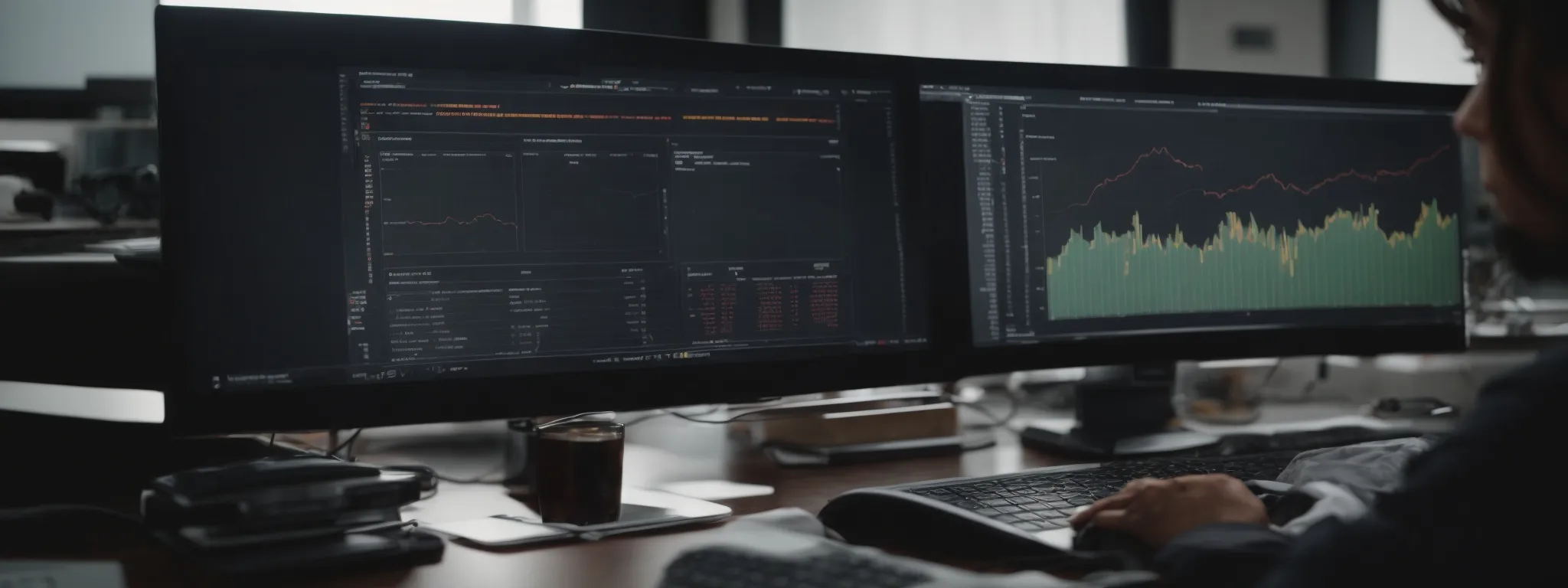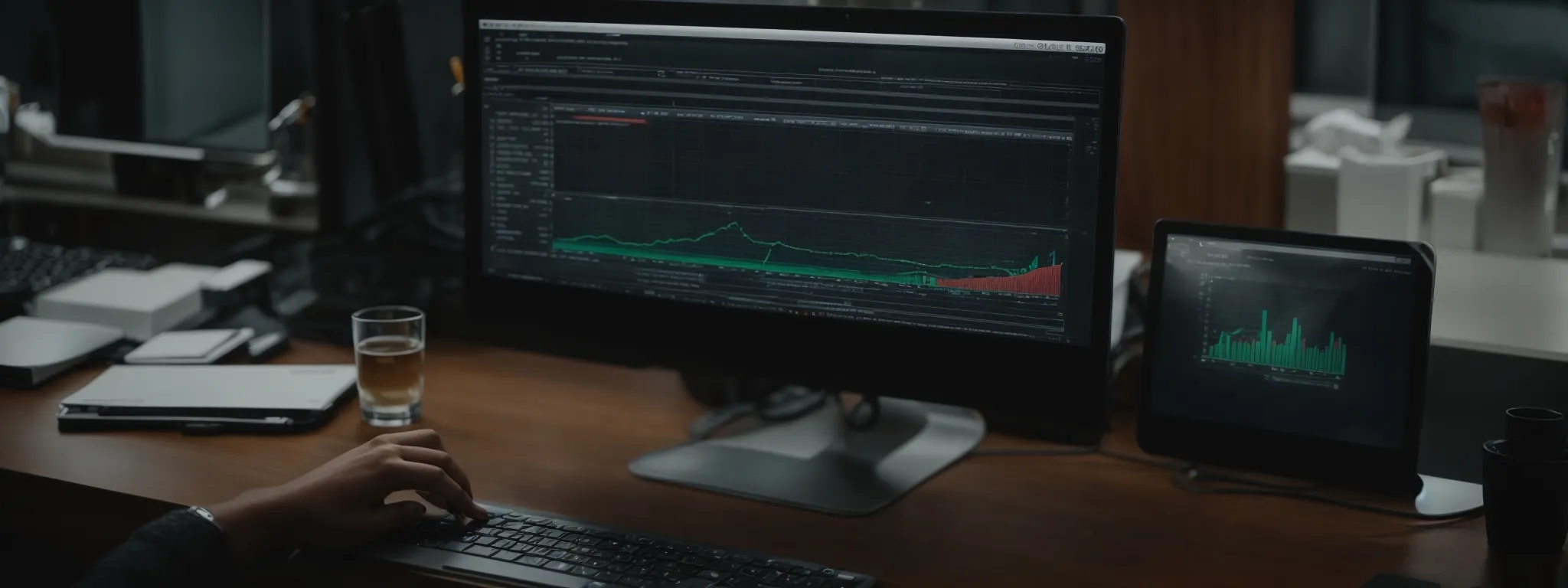Guide to Core Web Vitals in Technical SEO
Mastering Core Web Vitals: A Comprehensive Guide for Technical SEO In the digital landscape, speed is more than a convenience—it’s a vital component of user satisfaction and […]
Mastering Core Web Vitals: A Comprehensive Guide for Technical SEO
In the digital landscape, speed is more than a convenience—it’s a vital component of user satisfaction and search engine rankings.
Enter Core Web Vitals, Google’s latest initiative in refining the web, focused on delivering a seamless and engaging user experience.
These metrics measure the real-world performance of a page, reflecting loading times, interactivity, and visual stability.
Site owners and SEO professionals now prioritize these vital elements to climb the ranks in the ever-evolving algorithm of search results.
Keep reading to discover how mastering Core Web Vitals can become your strategic advantage in Technical SEO.
Key Takeaways
- Core Web Vitals Are Crucial Performance Metrics That Impact Site Rankings and User Experience
- LinkGraph’s SEO Services Prioritize the Optimization of Core Web Vitals Through Various Technical Strategies
- Google’s PageSpeed Insights and Lighthouse Are Essential Tools Used by LinkGraph to Analyze and Improve Web Performance
- Mobile Optimization of Core Web Vitals Is Fundamental in Today’s Mobile-First Indexing Environment
- Consistent User Experience Across Desktop and Mobile Devices Is Key to Technical SEO Excellence
Unveiling Core Web Vitals and Their Impact on SEO

In the realm of technical SEO, the introduction of Core Web Vitals by Google has ushered in a new era for site owners, developers, and SEO professionals alike, transforming the landscape of search engine rankings.
These Core Web Vitals serve as essential performance metrics to gauge the quality of user experiences on web pages.
As businesses strive to craft web experiences that meet these rigorous standards, understanding and mastery of Core Web Vitals become critical components of an SEO strategy.
This guide will delve into the intricacies of each Core Web Vital, elucidating their role in Technical SEO and how they directly influence a website’s online presence and user engagement.
LinkGraph’s SEO services and SearchAtlas SEO software stand at the forefront, offering cutting-edge tools and insights that enable website owners to navigate the complexities of these metrics and refine their web performance for optimal search engine results.
Defining Core Web Vitals for Better Understanding
Core Web Vitals are a set of specific factors that Google considers important in a webpage’s overall user experience. Comprising metrics such as Largest Contentful Paint (LCP), First Input Delay (FID), and Cumulative Layout Shift (CLS), these vitals offer concrete indicators for website performance, directly impacting a site’s ability to rank within search results.
Website performance is now inextricably linked to user satisfaction, a principle that underscores the ubiquitous importance of Core Web Vitals. LinkGraph acknowledges this reality, integrating Advanced Optimization Strategies into their SEO services, ensuring that clients’ websites not only meet but exceed the benchmarks set forth by these pivotal performance metrics.
Exploring the Direct Impact on Technical SEO
The symbiosis between Core Web Vitals and technical SEO cannot be overstated; the amalgamation of the two is radically reshaping the digital marketing landscape. Technical SEO involves optimizing the infrastructure of a website in such a way that search engines can crawl and index it effectively. With Core Web Vitals integrated into Google’s algorithm, SEO professionals need to prioritize these metrics to ensure that the technical foundations of a website align with the expectations of both search engines and users.
LinkGraph’s SEO services are acutely aware of this paradigm shift, advocating for an SEO framework that embeds Core Web Vitals within its core. By harmonizing technical components like site speed, interactivity, and visual stability with the broader SEO content strategy, they enable websites to provide stellar user experiences and, subsequently, gain favor in the eyes of search algorithms. Such strategic alignment is aimed at bolstering a website’s digital footprint and enhancing its visibility in the competitive landscape of search results.
Breaking Down the Core Web Vitals One by One

The pursuit of superior website function and form pivots on a trifecta of metrics known as Core Web Vitals – critical gauges that decipher the nuances of user experience.
At the heart of this lies the Largest Contentful Paint (LCP), a telling metric of load performance and visual readiness.
Side-stepping page load speed alone, LCP reveals the fabric of timely interactivity through First Input Delay (FID), thus marking the user’s real-time journey.
Meanwhile, the Cumulative Layout Shift (CLS) adds another dimension, offering a numeric testament to the fluidity and aesthetic stability of a website.
LinkGraph’s comprehensive approach to SEO delves into each Vital intricately, empowering their clients with knowledge and techniques to perfect these indicators and raise their site’s performance to the summit of search engine’s favour.
What Is Largest Contentful Paint (LCP)
The metric of Largest Contentful Paint (LCP) serves as a pivotal indicator of load performance, particularly concerning the largest piece of content that appears within the viewport. It is within these vital moments that the importance of LCP comes into play, as it measures the time taken for the page’s main content to load – a key factor in user perception of speed and efficiency.
An optimum LCP contributes significantly to an enriched user experience, as it reflects the point in the page load timeline where the user can absorb substantial visual information from the site:
- LCP measures the render time of the largest image or text block visible within the viewport, relative to when the page first starts loading.
- LinkGraph’s SEO services meticulously optimize this element, ensuring that the most impactful piece of content is promptly delivered to the user.
- Enhancing LCP is not solely about improving perceptions; it’s intricately tied to the user’s ability to interact with the page without undue delay.
Decoding First Input Delay (FID)
In the dance of digital interactions, First Input Delay (FID) emerges as a critical metric that captures the essence of user interactivity. It quantifies the time from a user’s first interaction with a page – like clicking a link or tapping a button – until the browser responds to that interaction.
LinkGraph’s SEO services hone in on reducing FID to assure that user commands are met with immediate action. An optimal FID ensures a seamless, responsive experience where users feel in control, essential for sustaining engagement and minimizing frustration:
| Core Web Vital | Importance | Optimal Benchmark |
|---|---|---|
| Largest Contentful Paint (LCP) | Load Performance | 2.5 seconds or faster |
| First Input Delay (FID) | User Interactivity | 100 milliseconds or less |
| Cumulative Layout Shift (CLS) | Visual Stability | 0.1 or less |
Understanding Cumulative Layout Shift (CLS)
The elusive metric of Cumulative Layout Shift (CLS) gauges the sum total of all unexpected layout shifts that occur during the lifespan of a webpage. Precise in its calculations, CLS measures the stability and consistency of a user’s visual experience, marking the instances when content unintentionally moves from one place to another, which can be jarring and disruptive from a user’s perspective.
LinkGraph’s SEO services target the optimization of CLS by meticulously refining web design elements to ensure that unexpected shifts are minimized, if not eliminated. This focus on visual steadiness is paramount, as it lays the groundwork for constructing trustworthy, user-centric pages that rank favorably with Google’s updated page experience signals, thereby enhancing overall search performance and visitor satisfaction.
Technical Strategies for Optimizing LCP

Attaining a favorable Largest Contentful Paint (LCP) score is vital for enhancing user experience and boosting a website’s SERP rankings.
Technical SEO specialists wield a host of optimization tactics to elevate LCP, with particular focus on above-the-fold content and image handling.
Prioritizing critical content in the user’s immediate view coupled with strategic image loading techniques can markedly improve load times, creating a swift, visually rich user entry point to any web page.
LinkGraph’s SEO services adeptly navigate these technical strategies, leveraging the full potential of above-the-fold content and lazy loading to optimize for speed and efficiency across client sites.
Prioritizing Above-the-Fold Content
Prioritizing above-the-fold content is indicative of LinkGraph’s nuanced understanding of user engagement and LCP optimization. They emphasize on delivering the most significant content to users as swiftly as possible, recognizing that initial impressions are critical to retention and subsequent interactions.
LinkGraph’s SEO services sharpen the focus on streamlining the delivery of content that appears first during a site visit. By reducing the amount of heavy content that loads initially, they ensure that the most important information is readily available, thereby enhancing the user’s experience and the page’s performance metrics.
Employing Lazy Loading for Offscreen Images
Embracing the tactic of lazy loading for offscreen images, LinkGraph’s SEO services offer a strategic advantage in enhancing page load speeds. This technique ensures that images outside the current browser’s viewport are not loaded until they become necessary, prioritizing user-visible content and thus streamlining the LCP measure.
LinkGraph’s proficiency in implementing lazy loading stems from their comprehensive approach to technical SEO, meticulously crafting experiences that keep bandwidth usage economical while Maintaining High Visual Fidelity as users scroll through a webpage. This focus on performance optimization is central to LinkGraph’s commitment to upholding the quality of user engagement with their clients’ websites.
How to Improve FID on Your Website

When sites falter on the metric of First Input Delay (FID), the culprit often dwells within the depths of code execution – specifically, the JavaScript that powers a multitude of web functions.
Addressing the efficiency of JavaScript execution is paramount for developers aiming to provide users with a responsive experience on their websites.
Similarly, optimizing the browser’s built-in event handlers plays a significant role in smoothing out the user’s interactive journey.
This segment explores the nuances of reducing JavaScript’s execution time and maximizing the browser’s native capabilities to enhance FID, ensuring that every click, scroll, and keystroke unfolds with reliable quickness and precision as part of LinkGraph’s extensive toolkit for on-page SEO services.
Minimizing JavaScript Execution Time
LinkGraph’s SEO services tackle the critical aspect of JavaScript execution, recognizing that protracted script processing times can negatively affect First Input Delay (FID). Their strategy encompasses the minimization of unnecessary JavaScript, enabling faster user interactions by expediting the code’s execution pathway.
Through an intricate process, LinkGraph’s technical teams optimize script execution by breaking down complex tasks into smaller, manageable chunks that browsers can interpret swiftly. This method effectively reduces delays in page responsiveness, ensuring A Superior User Experience directly aligned with improved FID scores.
Leveraging Browser’s Event Handlers Effectively
Leveraging browsers’ event handlers plays a pivotal role in enhancing the First Input Delay (FID) metric, a crucial concern for LinkGraph’s seasoned SEO professionals. By optimizing event handling, they ensure that user interactions, such as clicks and keystrokes, are managed efficiently, reducing the time between user input and browser response.
LinkGraph’s expert team applies best practices to event processing, instituting non-blocking event listeners, and deferring non-essential scripts, thus streamlining the processing of user interactions. This focus on the effective use of event handlers contributes significantly to A Fluid User Experience, emblematic of the technical finesse embodied in their SEO services.
Tackling CLS for a More Stable User Experience

In the quest for technical excellence in SEO, addressing Cumulative Layout Shift (CLS) is integral to fostering a stable and reliable user interface.
Users demand and merit a browsing experience devoid of unforeseen content movements that disrupt their interaction.
Meticulous planning and precise structuring of web elements are foundational to curtailing layout shifts that negatively influence user engagement and, consequently, search engine rankings.
This section delves into effective methods to calibrate layout shift measurements and outlines strategies for averting those disruptive, unexpected content shifts that can undermine a website’s standing in the eyes of its audience and the algorithms that shape its online destiny.
Making Layout Shift Measurements
To ascertain the extent of visual instability on a webpage, a meticulous assessment of Cumulative Layout Shift (CLS) measurements is indispensable. LinkGraph’s advanced SEO practices involve a Thorough Analysis of Each Unintended Movement, leveraging tools like SearchAtlas SEO software to quantify the impact of shifts and identifying the root causes behind them.
LinkGraph’s SEO prowess is evident in their capability to interpret the nuances of layout shift data, pinpointing areas that require optimization. By analyzing user interface events with precision, their expertise contributes to crafting web pages that exude stability, ensuring an unswerving and cohesive browsing journey for end-users.
Avoiding Unexpected Content Shifts
Securing a stable user interface demands attentiveness to detail in order to sidestep the unexpected content shifts that can mar user experiences: LinkGraph’s SEO services systematically address this aspect by fortifying web page elements against unforeseen movement.
| Strategy | Impact on CLS | Benefits to User Experience |
|---|---|---|
| Reserving Space for Dynamic Content | Minimizes layout shifts | Prevents content jumping, enhances navigability |
| Optimizing Ad Placement | Reduces unexpected layout changes | Creates a seamless browsing experience |
| Utilizing Aspect Ratio for Media | Stabilizes visual load-ins | Delivers a consistent viewing area |
By prescribing strategic measures such as embedding dimension attributes for media elements and refining resource loading protocols, LinkGraph ensures content fluidity across client websites. The adoption of these practices significantly augments the site’s visual stability, a critical facet of SEO that fosters user retention and engagement.
Utilizing Tools to Measure Core Web Vitals

For SEO professionals dedicated to refining the technical characteristics of their websites, accurately measuring Core Web Vitals is pivotal to success.
Skillful use of diagnostic tools allows for an in-depth analysis and understanding of these vital metrics.
Among the most esteemed instruments in the SEO toolkit are Google’s PageSpeed Insights and the Google Lighthouse auditing tool.
Both utilities offer robust analyses and precise recommendations for website optimization, facilitating A Structured Approach to Enhance Site Performance in line with Core Web Vitals and, by extension, page experience standards.
Mastery of these tools is instrumental in executing a sophisticated Technical SEO campaign.
Navigating Google’s PageSpeed Insights
Google’s PageSpeed Insights emerges as an invaluable asset for SEO professionals aiming to dissect and elevate their website’s compliance with Core Web Vitals. This tool dissects page performance across both mobile and desktop devices, providing immediate insights into areas where optimization can manifest in tangible improvements to user experience and SERP positions.
As one dives into the PageSpeed Insights report, it becomes clear that the tool goes beyond superficial metrics, offering a granular analysis of elements such as First Contentful Paint and Time to Interactive, which are integral to shaping a website’s overall performance narrative. LinkGraph leverages these insights to formulate strategies that Meticulously Tune the Intricate Parts of a website, aligning its technical aspects with Google’s expectations for a stellar user experience.
Exploiting the Capabilities of Google Lighthouse
Within the arsenal of essential SEO tools, Google Lighthouse stands out as a dynamic utility empowering LinkGraph’s SEO services to conduct thorough audits geared towards the improvement of Core Web Vitals. By tapping into Lighthouse’s comprehensive reporting on performance, accessibility, progressive web apps, and more, LinkGraph’s expertise is able to distill actionable insights tailored to elevate a Website’s Technical Prowess and user experience.
Google Lighthouse’s autonomous auditing capabilities serve as a beacon for LinkGraph’s approach to technical optimization, offering the depth of analysis required to diagnose and rectify issues impeding a site’s adherence to Core Web Vitals. It is with this exacting tool that LinkGraph formulates enhancements, solidifying a website’s foundational SEO elements and fortifying its performance benchmarks within the digital ecosystem.
Implementing Core Web Vitals Improvements Across Devices

In an environment where web traffic is increasingly dominated by mobile users, the imperative to optimize Core Web Vitals for mobile devices is at an all-time high.
Addressing mobile-specific performance concerns not only enhances the user experience on handheld devices but also aligns with Google’s mobile-first indexing approach.
Ensuring a consistent user experience across all platforms, including both desktop and mobile, is a nuanced challenge that calls for a deft balance between responsive design and performance optimization.
Embracing these refinements is critical for webmasters and SEO practitioners aiming for technical SEO excellence in a cross-device digital landscape.
Addressing Mobile-Specific Performance Issues
In the era of ubiquitous mobile browsing, webmasters cannot afford to overlook the performance issues unique to smartphones and tablets. LinkGraph’s SEO services specialize in optimizing Core Web Vitals for mobile frameworks, ensuring that load times and interactive elements are tailored to meet the demands of on-the-go users.
Utilizing sophisticated diagnostics and responsive design techniques, LinkGraph confronts mobile-specific challenges head-on. Their dedication to fine-tuning technical aspects such as touch responsiveness and mobile loading speeds exemplify their commitment to elevating the mobile user experience to the highest standard.
Ensuring a Consistent Experience on Both Desktop and Mobile
Delivering a uniform Core Web Vitals experience across desktop and mobile platforms is crucial, as users increasingly switch between devices during their digital interactions. LinkGraph’s SEO services are designed to ensure that websites maintain consistent functionality and design, regardless of the device or screen size.
The cross-device consistency not only fosters user trust and satisfaction but also aligns with the versatility that modern SEO demands. Through adaptive design and rigorous performance testing, LinkGraph aids in crafting websites that stand resilient in the face of fluctuating usage patterns and diverse hardware capabilities:
| Core Web Vital | Desktop Standard | Mobile Requirement |
|---|---|---|
| Largest Contentful Paint (LCP) | Fast loading of main content | Optimized images & prioritized resources |
| First Input Delay (FID) | Seamless interactivity | Minimized JavaScript execution |
| Cumulative Layout Shift (CLS) | Stable layouts without shifts | Responsive design for unpredicted content flow |
Conclusion
In summary, mastering Core Web Vitals is crucial for the success of any technical SEO strategy.
These metrics—Largest Contentful Paint (LCP), First Input Delay (FID), and Cumulative Layout Shift (CLS)—are key indicators of a webpage’s overall user experience and performance.
LinkGraph’s SEO services, along with tools like SearchAtlas SEO software, offer essential insights and optimization techniques to improve these vitals, ensuring that websites not only comply with Google’s standards but also provide a stellar experience for users across all devices.
By prioritizing these metrics, businesses can significantly enhance their online presence, user engagement, and ultimately, their search engine rankings.















































































